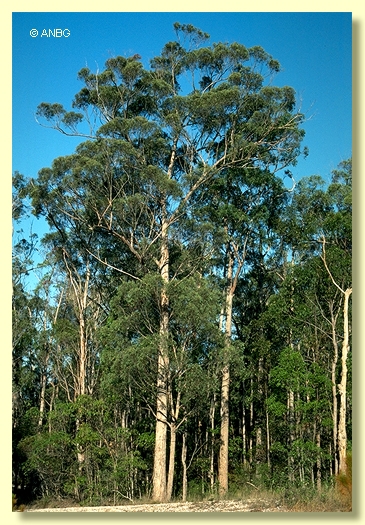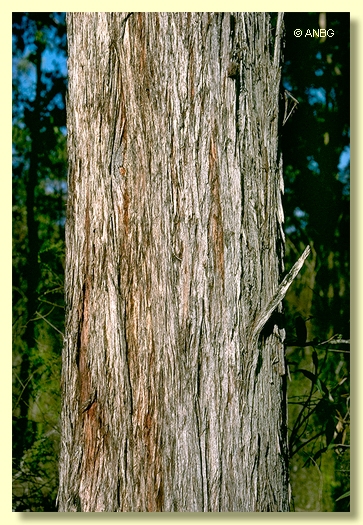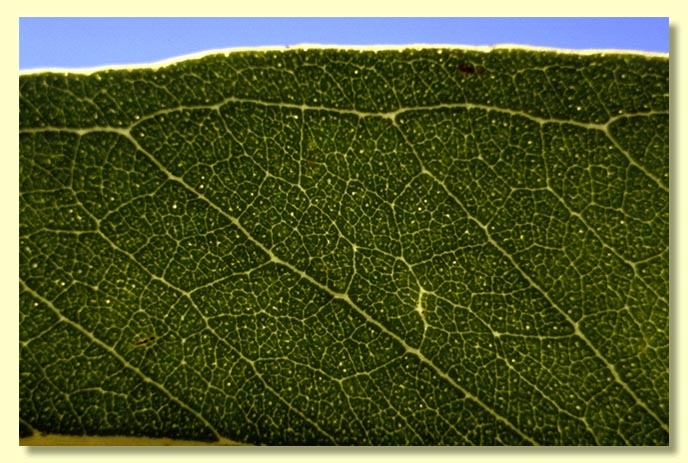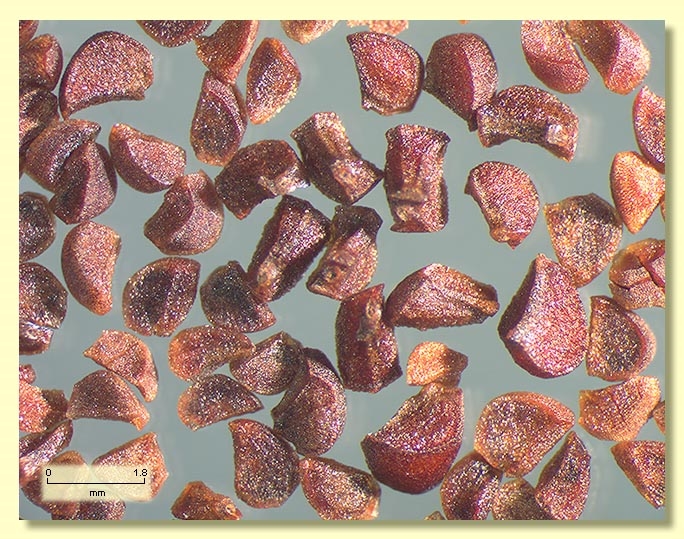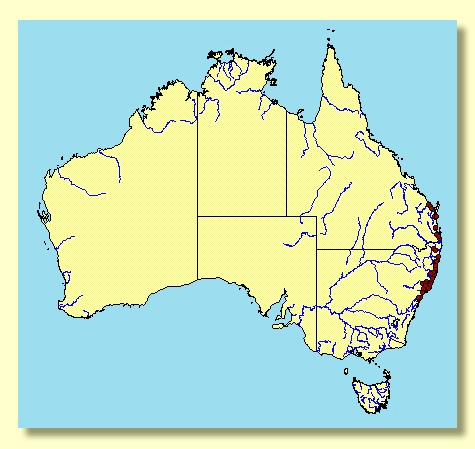Euclid - Online edition
Eucalyptus carnea
Eucalyptus | Eucalyptus | Amentum
E. triantha var. carnea Domin, Beitrage zur Flora und Pflanzengeographie Australiens 22 (89): 1016 (1928); fide K.D.Hill, Telopea 8 (2) 241 (1999).
E. umbra subsp. carnea (R.T.Baker) L.A.S.Johnson, Contr. New South Wales Natl Herb. 3: 123 (1962). E. acmenoides var. carnea (R.T.Baker) Maiden, Crit. Revis. Eucalyptus 1: 265 (1907).
T: Woodburn, NSW, W.Bäuerlen s.n.; lecto: NSW, fide S.T.Blake, Proc. Roy. Soc. Queensland 69: 86 (1958); isolecto: MEL.
Bark rough to small branches, stringy or fibrous, grey or grey-brown.
Juvenile growth (coppice or field seedlings to 50 cm): stems round in cross-section; juvenile leaves opposite, sessile and amplexicaul at first, then petiolate and alternate by 6 to 12 nodes, ovate, 8–20 cm long, 3.5–10 cm wide, discolorous, green, lamina held horizontally; eventually becoming lanceolate, concolorous, blue-green and held vertically.
Adult leaves alternate, petiole 1–2 cm long; blade lanceolate or falcate, 8–17 cm long, 1.7–4 cm wide, base usually oblique, concolorous to weakly discolorous, dull, blue-green, side-veins usually greater than 45° to midrib, moderately to densely reticulate, intramarginal vein parallel to and well-removed from margin, oil glands mostly island.
Inflorescence occasionally terminal compound, more often axillary unbranched, peduncles 1–2.2 cm long, buds in umbels of 7, 9 or 11 per umbel, pedicels 0.3–0.7 cm long. Mature buds buds fusiform or ovoid (0.6–0.7 cm long, 0.3–0.4 cm wide), scar absent, operculum conical to slightly beaked, stamens irregularly flexed, anthers reniform to cordate, versatile, dorsifixed, dehiscing by confluent slits, style long, stigma tapered, locules 3 or 4, the placentae each with 2 vertical ovule rows. Flowers white.
Fruit pedicellate (pedicels 0.2–1 cm long), cup-shaped, hemispherical or truncate-globose, 0.3–0.7 cm long, 0.5–0.8 cm wide, disc narrow, usually level or weakly descending or weakly raised, valves 3 or 4, near rim level.
Seeds brown, 1–1.5 mm long, pyramidal or obliquely pyramidal, dorsal surface smooth, hilum terminal.
Cultivated seedlings (measured at ca node 10): cotyledons reniform; stems rounded in cross-section; leaves opposite for at least 10 nodes, sessile at lower nodes but becoming shortly petiolate, ovate-lanceolate, 8–12 cm long, 3.5–6 cm wide, base amplexicaul to lobed or tapering, discolorous, darker green and glossy above.
Flowering has been recorded in April, September, October and November
A small to medium-sized tree with a coastal and subcoastal distribution from the Hunter River in New South Wales north towards Gympie in south-eastern Queensland. It occurs on poor skeletal soils. Eucalyptus carnea has finely fibrous rough bark and a green to bluish green crown of ± concolorous, thick-textured adult leaves with densely reticulate venation, ± hemispherical fruit usually with disc level or only slightly descending or slightly raised, and broadly ovate juvenile leaves that are sessile and opposite for ca eight nodes before becoming alternate and shortly petiolate.
Within its natural range the bark type of Eucalyptus carnea will distinguish it from other species except species of stringybark, E. consideniana, E. piperita, E. microcorys, and other white mahogany species.
All species of stringybark have adult leaves with sparsely reticulate venation and a quick inspection of fresh adult leaves against strong sunlight will be informative. In addition stringybarks have furrowed bark with much longer "stringy" fibres, thicker-walled fruit with prominent disc and juvenile leaves that are scabrid/hairy at the lower nodes at least.
E. consideniana and E. piperita both differ from E. carnea in having juvenile leaves that are petiolate and alternate. E. consideniana also has sparsely reticulate adult leaves and barrel-shaped to obconical fruit whilst E. piperita has somewhat similar adult leaf venation to E. carnea but has barrel-shaped to urceolate fruit. Both species occur in dry sclerophyll forest but no further north than about the latitude of Buladelah in central coastal New South Wales.
E. microcorys occurs in wet sclerophyll forest from Sydney north to Gympie and thus overlaps in distribution with E. carnea but not in habitat. E. microcorys differs clearly in having buds arranged in compound axillary inflorescences, the operculum shallowly rounded and when fresh has a visible "cross" marking reflecting its origin as 4 petals, fruit that are obconical, and juvenile leaves alternate and petiolate.
Within the white mahogany group of species E. carnea differs from E. acmenoides and E. helidonica in occupying a drier habitat, having thicker-textured concolorous to weakly discolorous adult leaves (never strikingly discolorous as in E. acmenoides and E. helidonica ), juvenile leaves that are opposite and sessile for only six to 12 pairs, then becoming alternate and petiolate (persisting opposite and sessile for up to 1 m of juvenile growth in E. acmenoides and E. helidonica). E. apothalassica occurs west of the distribution of E. carnea and the former has juvenile leaves that are narrower and persist opposite and sessile for longer. E. psammitica differs from E. carnea in having slightly larger fruit and juvenile leaves that are narrower and persist opposite and sessile for longer.
The only other white mahogany species likely to be confused with E. carnea are E. umbra and E. latisinensis. Both have a similar juvenile phase to E. carnea and are similar in fruit size and shape. The only differences seem to be that the presentation of the disc is more often flat or slightly raised in both E. umbra and E. latisinensis, giving the fruit a flat-topped appearance. Historically E. carnea and E. umbra have been regarded as subspecies (of E. umbra) thought to differ in crown colour with E. carnea having a bluish crown and E. umbra a green crown. We doubt this on the basis of field inspection. E. carnea may have a green crown at least sometimes. E. latisinensis scarcely differs from E. umbra. Plainly more careful research is needed here.
MORE ABOUT WHITE MAHOGANIES

